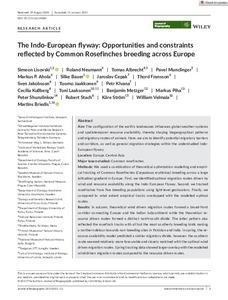The Indo-European flyway: Opportunities and constraints reflected by Common Rosefinches breeding across Europe
Lisovski Simeon; Neumann Roland; Albrecht Tomas; Munclinger Pavel; Ahola Markus P; Bauer Silke; Cepak Jaroslav; Fransson Thord; Jakobsson Sven; Jaakkonen Tuomo; Klvana Petr; Kullberg Cecilia; Laaksonen Toni; Metzger Benjamin; Piha Markus; Shurulinkov Peter; Stach Robert; Ström Kåre; Velmala William; Briedis Martins
https://urn.fi/URN:NBN:fi-fe2021042822171
Tiivistelmä
Aim
The configuration of the earth's landmasses influences global weather systems and spatiotemporal resource availability, thereby shaping biogeographical patterns and migratory routes of animals. Here, we aim to identify potential migratory barriers and corridors, as well as general migration strategies within the understudied Indo-European flyway.
Location
Europe, Central Asia.
Major taxon studied
Common rosefinches.
Methods
We used a combination of theoretical optimization modelling and empirical tracking of Common Rosefinches (Carpodacus erythrinus) breeding across a large latitudinal gradient in Europe. First, we identified optimal migration routes driven by wind and resource availability along the Indo-European flyway. Second, we tracked rosefinches from five breeding populations using light-level geolocators. Finally, we compared to what extent empirical tracks overlapped with the modelled optimal routes.
Results
In autumn, theoretical wind driven migration routes formed a broad-front corridor connecting Europe and the Indian Subcontinent while the theoretical resource driven routes formed a distinct north-south divide. The latter pattern also reflected the rosefinch tracks with all but the most southerly breeding birds making a northern detour towards non-breeding sites in Pakistan and India. In spring, the resource availability model predicted a similar migratory divide, however, the southern route seemed relatively more favourable and closely matched with the optimal wind driven migration routes. Spring tracking data showed larger overlap with the modelled wind driven migration routes compared to the resource driven routes.
Main conclusions
Optimal wind and resource driven migration routes along the Indo-European flyway are seasonally specific and to a large extend do not overlap with one another. Under these conditions, migratory birds adopt seasonally distinct migration strategies following energy minimization strategy in autumn, driven by resource availability, and time minimizing strategy in spring, driven by wind conditions. Our optimal migration models can be applied worldwide and used to validate against empirical data to explain large-scale biogeographic pattern of migratory animals.
Kokoelmat
- Rinnakkaistallenteet [27094]
